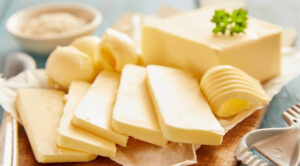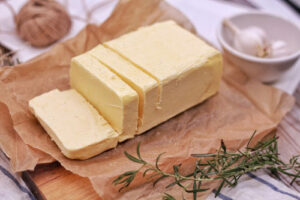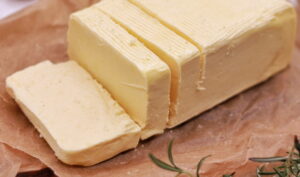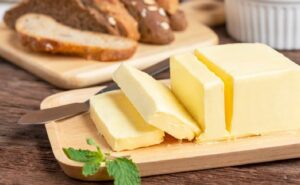
Ukrproduct Group, a major Ukrainian producer of packaged butter and processed cheese, maintained stable production levels at its main production sites in January-September 2025 and implemented business continuity protocols that had been refined since the start of the full-scale invasion.
“Exports accounted for 20.4% of total sales, strengthening the group’s position as one of Ukraine’s leading dairy exporters,” the company said in a report published on the London Stock Exchange on Thursday.
At the same time, processed cheese production volumes fell by 8.5%, which the company attributed to lower demand in the domestic market.
At the same time, Ukrproduct’s sales of processed cheese products increased by 8.1% due to consumers switching to cheaper alternatives. Sales of butter on the domestic market declined due to a significant decrease in profitability, but overall they increased by 25.8% due to exports.
The increase in exports of spreads boosted sales of spreads by 5% and sales of skimmed milk powder and skimmed milk products by 74.7%.
At the same time, kombucha sales increased by 30.6%, while kvass sales decreased by 13.3% due to cooler summer weather and a reduction in the number of keg sales outlets, the company explained.
During the period in question, Ukrproduct increased its sales of sunflower seeds more than fourfold, which it attributed to the diversification of its product range.
“Profitability remained under pressure due to dependence on diesel fuel, product spoilage, inflation in raw material prices, rising personnel costs, and continued instability in the energy sector,” the company said.
Ukrproduct Group is a large Ukrainian producer of packaged oil, processed cheese, and kvass. It produces dairy products under the trademarks Nash Molokhnik, Nash Sirok, Molendam, and Vershkovaya Dolina, as well as kvass under the trademark Arsenyevsky.
Ukrproduct Group consists of two plants in Zhytomyr (one specializing in processed cheese, the other producing kvass), as well as two enterprises in the Khmelnytskyi region: a milk plant in Starokostiantyniv, which produces packaged butter, spreads, cheese, and dry milk, and a dairy plant in Letychiv.
The group’s production facilities have the capacity to produce up to 70,000 tons of dairy products per year.

Fatty dairy products will continue to fall in price in Ukraine, with prices falling by 30-35% by New Year’s Eve and the trend continuing until the first half of 2026, according to Olena Zhupinas, deputy director general of the Association of Milk Producers (AMP), speaking on Ukrainian Information Service.
The expert noted that the main reason for the decline in dairy product prices is the reduction in product costs on the European market.
“Since the end of summer, global butter prices have fallen by more than 30%. Ukrainian exporters sold this product to the EU last year at EUR7 per kilogram. Now the price is no higher than EUR4.5,” Zhupinas explained.
According to her, Ukrainian processors are now refocusing on domestic consumers, and the decline in butter prices is already noticeable. This will continue in the future, according to AVM forecasts, but mainly in the form of sales promotions in retail chains: 30-35% off on store shelves.
“This decline has significantly affected the purchase prices of raw milk. In mid-November, the cost of ‘extra’ grade milk, which meets European requirements, fell by 17%. Under these conditions, many producers are working at cost, and some are even operating at a loss,” the AVM expert concluded.

The situation on the Ukrainian butter market is deteriorating after active summer exports, company warehouses are filling up, domestic sales are becoming increasingly difficult, and exports are facing additional challenges, according to industry analytical agency Infagro.
“Currently, only those producers who are willing to significantly reduce prices can sell their products consistently. These are usually companies that lack working capital. However, the current price level is unprofitable for most producers operating in the butter segment, along with skimmed milk powder or casein,” analysts explained.
They pointed out that due to the rise in raw material prices, production is becoming less profitable: the purchase prices for milk required to break even remain unattainable for most companies.
At the same time, at the end of October, there was a noticeable decrease in the price of block butter, while manufacturers of packaged products are in a slightly better position, but competition in this market is intensifying.
To increase sales, companies are forced to offer promotional discounts, which negatively affects profitability.
“The situation with exports is also difficult. Some companies are lowering prices to stay in foreign markets, particularly in Moldova. Demand for Ukrainian butter in the Caucasus remains, but sales volumes there are limited,” experts noted.
According to their information, expectations of additional opportunities after the introduction of new duty-free quotas to the EU have not been met—demand from European traders is accompanied by lower price offers that do not cover production costs.
Due to the unprofitability of production, some factories have already reduced or temporarily suspended butter production. As a result, production volumes in October were lower than last year, which is the first such case in recent times, Infagro concluded.

Unrealized exchange commodities, growing losses in dry milk and butter production, and falling butter prices in Europe and worldwide are holding back the growth of raw milk prices in Ukraine, according to the Association of Milk Producers (AMP).
The industry association noted that the average purchase price of extra-grade milk as of October 6 was UAH 17.45/kg excluding VAT, which is UAH 0.1 more than in the previous month, Prices for premium milk (UAH 17.15/kg excluding VAT) and first-grade milk (UAH 16.80/kg excluding VAT) remained unchanged.
“Prices also remained stable compared to the results of monitoring in the second half of September. Compared to the same period last year, the price of extra grade milk decreased by 25 kopecks,” experts noted.
According to AVM analyst Georgiy Kukhaleishvili, many factors are holding back the growth of raw milk prices in Ukraine. Currently, the supply of exchange goods on the domestic market exceeds demand. Milk processing enterprises have been working at full capacity since mid-August after the suspension of milk exports to the EU following the exhaustion of quotas. At the same time, demand on the domestic market remains low due to a decrease in the number of consumers and a reduction in the purchasing power of the population. Sales of dairy products in supermarkets are growing only when promotional discounts are offered. Warehouses in Ukraine are almost completely filled with exchange goods, which puts pressure on milk prices.
According to the ABM, the situation with butter in the EU is indicative, as it has fallen in price by 24% over the past two months due to the arrival of American butter on the European market at a price of EUR 5,000/ton. In such conditions, European traders are not interested in buying Ukrainian butter, which costs more than American butter. The increase in electricity costs affects the growth of the cost of Ukrainian products and makes it difficult to compete with Americans in the European market, analysts explain.
In Ukraine, in the second half of October, there is a possibility of a maximum price reduction for extra-grade and higher-grade raw milk due to the growing unprofitability of dry milk and butter production at milk processing enterprises and a decline in world prices for butter, they predict.
“However, on October 13, new quotas for the export of dairy products to the EU for Ukrainian companies are expected to be signed. Quotas for butter have increased from 5,000 tons to 7,000 tons, as well as for dry milk. Dairy exports to the EU are expected to resume on October 28, after the quotas come into force in 15 days, which may curb the fall in raw milk prices in Ukraine,” the ABM notes.

“Ukrproduct Group, a major Ukrainian producer of packaged butter and processed cheese, increased production of kvass and beverages by 42.5% in local currency in the first half of 2024 and increased their output by 13.1% compared to the first half of 2023, the company said in a report to the London Stock Exchange on Monday.
Sales of kvass and other beverages in the first half of 2024 amounted to GBP1.1 million (…). This growth was driven by a combination of price increases, new product launches, distribution expansion, and favorable weather conditions for sales, the agricultural holding said.
The volume of oil sales in the first half of 2024 amounted to GBP1.8 million, which is 25.6% more in monetary terms and 9.5% more in production compared to the same period last year. Sales were made through the key sales channels – retailers, large distributors and exports.
In the Processed Cheese and Processed Cheese Products segment, sales amounted to GBP10.7 million, which represents a decrease in revenue of 2.2% in local currency and a decrease in volume of 10.8% compared to 1H2023.
“This was mainly due to financial difficulties for some clients and a shift in focus towards profitability,” Ukrproduct Group explained.
Spread sales for the reporting period decreased to GBP1.7 million, down 14.1% in local currency and 13.1% in volume compared to the same period last year. The agricultural holding explained the decline by increased competition in the market.
Skimmed milk powder sales for the six months of 2024 also decreased by 14.2% in local currency to GBP0.5 million and by 14.7% in volume compared to the same period last year, which is a continuation of the downward trend of the previous season.
Due to low prices for skimmed milk powder, the group minimized the production of this product, deciding instead to use semi-finished milk protein as an ingredient in the production of processed cheese, the agricultural holding said.
“Business development in the second half of 2024 remains extremely uncertain due to the ongoing war in Ukraine.
The Group continues to make every effort to implement its strategy in a very challenging business environment, not least by ensuring a stable electricity supply and responding to new challenges. In the next six months, the Group expects to focus on maintaining its existing production capacity, supporting sales volumes and continuously improving operational efficiency,” Ukrproduct Group summarized.
“Ukrproduct Group is a major Ukrainian producer of packaged butter, processed cheese and kvass. The company produces dairy products under the Nash Molochnyk, Nash Syrok, Molendam, and Vershkova Dolina brands and kvass under the Arsenievsky brand.
Ukrproduct Group operates two plants in Zhytomyr (one specializing in processed cheese and the other producing kvass) and two enterprises in Khmelnytsky region: a dairy plant in Starokonstantinov producing packaged butter, spreads, cheese and milk powder, and a dairy plant in Letychiv.
The group’s production capacity allows it to produce up to 70 thousand tons of dairy products per year.

In Ukraine, following the European Union, butter prices continue to rise, with prices in Europe reaching record levels, according to Infagro, an industry analytical agency.
“Not all Ukrainian butter producers can take advantage of the opportunity to make good money on butter exports, as it was in 2022. There is currently a physical lack of raw materials to produce large volumes,” the analysts said.
According to their information, due to rising prices and a number of other factors, butter production decreased slightly in August. This will be followed by a decline in production of this commodity due to a lack of raw materials at affordable prices.
They noted that domestic butter prices are also rising alongside export prices, albeit with a certain lag. Butter prices will continue to rise, at least domestically. Analysts predict a price collapse in foreign trade in mid-autumn.
Infagro noted that the production of spreads and vegetable-cream mixtures is currently stable, but should increase in the near future. Demand for alternative milk fats will increase given the current price of butter.